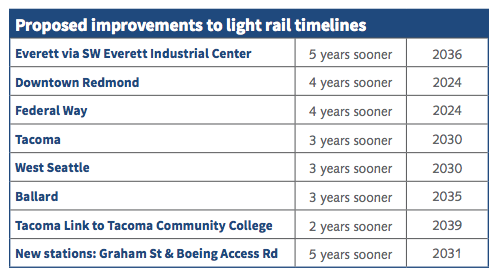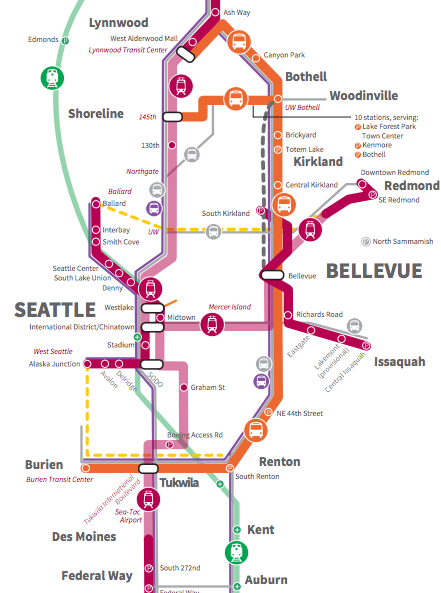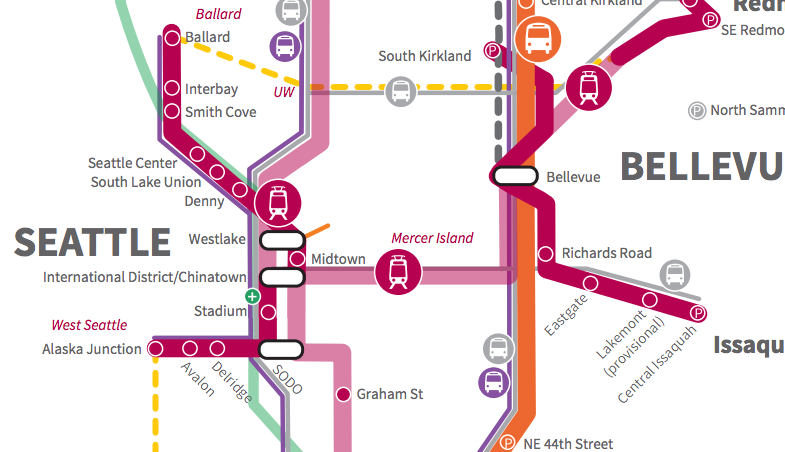At Thursday’s board meeting, Sound Transit responded to the large amount of public comment that was received on the Sound Transit 3 (ST3) package draft proposal, most significantly by announcing that the timelines for most projects have now been moved up, shortening their time to completion by two to five years.

The updated timelines come from both a more optimistic financial outlook from Sound Transit’s finance division, as well as a faster planning process for these lines. This is welcome news for those who were viewing ST3 as being much too long-term to provide benefit to residents in our region when they are needed. But there are a number of changes that were announced today that will dramatically improve the quality of the lines no matter the timeline for delivery.

The most important is probably the announcement that light rail from Downtown Seattle to Ballard will be entirely grade-separated, dramatically improving reliability, on top of being completed by 2035, three years sooner than planned. The previously planned at-grade section along 15th Ave W will now be elevated, so it is likely that a drawbridge over Salmon Bay will be retained in the plan.
Another big part of yesterday’s meeting was the news that the infill station in north Seattle at 130th Street will be fully funded by ST3, and will not be purely provisional as funds allow. This is a big victory that bodes well for the creation of another urban village in Seattle that can provide the opportunity for transit-oriented-development.
As for shorter-term transit improvements, the initial ST3 draft plan did not include any funds for the Madison BRT project. This was a surprise to anyone who had attended Madison BRT planning events, as the planners had clearly planned on being able to utilize Sound Transit funds. Madison BRT is now included in the plan, along with funding for additional improvements to RapidRide C and D lines (but curiously not the E, which has higher ridership). This places Madison BRT’s funding, which was to be supplanted from Move Seattle funds, in more secure territory especially with regard to securing any federal matching funds.
At the last Sound Transit executive session, the idea of who would be asked to pay for a new Downtown Seattle tunnel was raised. Since the new tunnel is viewed as a regional asset that will benefit the entire system, taking pressure off the existing Downtown Seattle transit tunnel, it is possible that the normal concept of subarea equity—that funds collected from within North King County, say, should be spent on projects in that area only—could be set aside. At Thursday’s meeting, it was broken down that with subarea equity being set aside, the portion of payment being collected from each subarea for the Downtown tunnel will not be equal for all areas, but instead based on projected ridership. Exactly how this will be determined systemwide will play out in the next few months.
Systemwide, there is an expansion of parking facilities from the previous plan. A new park-and-ride has been added in North Sammamish (not along any planned light rail line) and parking will expand at the new DuPont Sounder station. A possible showdown between parking spending (which could top $1 billion) and bike and pedestrian access is certainly possible.
Overall, it is a positive sign that Sound Transit was so quick to respond to the large amount of public comment they received and respond accordingly. The package being formed here is a stronger one that will serve the region better and on a quicker schedule. However, it remains to be seen if the densest areas of our region will receive the level of investment that is required compared to some of the questionable investments that do not appear to be justified by ridership or travel time. We will continue to report on those projects as more information becomes available.
Ryan Packer has been writing for The Urbanist since 2015, and currently reports full-time as Contributing Editor. Their beats are transportation, land use, public space, traffic safety, and obscure community meetings. Packer has also reported for other regional outlets including BikePortland, Seattle Met, and PubliCola. They live in the Capitol Hill neighborhood of Seattle.


